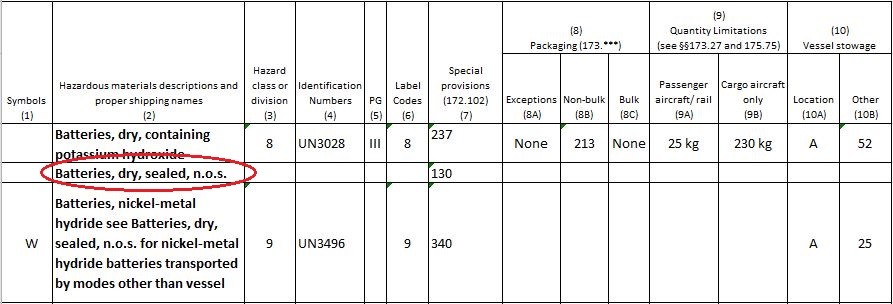If the classification of batteries you intend to offer for transportation leads you to this entry in the Hazardous Materials Table of 49 CFR 172.101:
Then, you may immediately notice the absence of any information in the Table other than the proper shipping name in column 2 and the Special Provision (130) in column 7. The presence of the proper shipping name appearing in bold (Roman) print in column 2 indicates that PHMSA has identified it as a hazardous material; but we need to know more, and that leads us to the Special Provision in column 7. According to 49 CFR 172.101(h):
(h) Column 7: Special provisions. Column 7 specifies codes for special provisions applicable to hazardous materials. When Column 7 refers to a special provision for a hazardous material, the meaning and requirements of that special provision are as set forth in §172.102 of this subpart.
So, to understand the meaning of Special Provision 130 you must refer to 49 CFR 172.102 where we find:
130 “Batteries, dry, sealed, n.o.s.,” commonly referred to as dry batteries, are hermetically sealed and generally utilize metals (other than lead) and/or carbon as electrodes. These batteries are typically used for portable power applications. The rechargeable (and some non-rechargeable) types have gelled alkaline electrolytes (rather than acidic) making it difficult for them to generate hydrogen or oxygen when overcharged and therefore, differentiating them from non-spillable batteries. Dry batteries specifically covered by another entry in the §172.101 Table must be transported in accordance with the requirements applicable to that entry. For example, nickel-metal hydride batteries transported by vessel in certain quantities are covered by another entry (see Batteries, nickel-metal hydride, UN3496). Dry batteries not specifically covered by another entry in the §172.101 Table are covered by this entry (i.e., Batteries, dry, sealed, n.o.s.) and are not subject to requirements of this subchapter except for the following:
(a) Incident reporting. For transportation by aircraft, a telephone report in accordance with §171.15(a) is required if a fire, violent rupture, explosion or dangerous evolution of heat (i.e., an amount of heat sufficient to be dangerous to packaging or personal safety to include charring of packaging, melting of packaging, scorching of packaging, or other evidence) occurs as a direct result of a dry battery. For all modes of transportation, a written report submitted, retained, and updated in accordance with §171.16 is required if a fire, violent rupture, explosion or dangerous evolution of heat occurs as a direct result of a dry battery or battery-powered device.
(b) Preparation for transport. Batteries and battery-powered device(s) containing batteries must be prepared and packaged for transport in a manner to prevent:
(1) A dangerous evolution of heat;
(2) Short circuits, including but not limited to the following methods:
(i) Packaging each battery or each battery-powered device when practicable, in fully enclosed inner packagings made of non-conductive material;
(ii) Separating or packaging batteries in a manner to prevent contact with other batteries, devices or conductive materials (e.g., metal) in the packagings; or
(iii) Ensuring exposed terminals or connectors are protected with non-conductive caps, non-conductive tape, or by other appropriate means; and
(3) Damage to terminals. If not impact resistant, the outer packaging should not be used as the sole means of protecting the battery terminals from damage or short circuiting. Batteries must be securely cushioned and packed to prevent shifting which could loosen terminal caps or reorient the terminals to produce short circuits. Batteries contained in devices must be securely installed. Terminal protection methods include but are not limited to the following:
(i) Securely attaching covers of sufficient strength to protect the terminals;
(ii) Packaging the battery in a rigid plastic packaging; or
(iii) Constructing the battery with terminals that are recessed or otherwise protected so that the terminals will not be subjected to damage if the package is dropped.
(c) Additional air transport requirements. For a battery whose voltage (electrical potential) exceeds 9 volts—
(1) When contained in a device, the device must be packaged in a manner that prevents unintentional activation or must have an independent means of preventing unintentional activation (e.g., packaging restricts access to activation switch, switch caps or locks, recessed switches, trigger locks, temperature sensitive circuit breakers, etc.); and
(2) An indication of compliance with this special provision must be provided by marking each package with the words “not restricted” or by including the words “not restricted” on a transport document such as an air waybill accompanying the shipment.
(d) Used or spent battery exception. Used or spent dry batteries of both non-rechargeable and rechargeable designs, with a marked rating up to 9-volt that are combined in the same package and transported by highway or rail for recycling, reconditioning, or disposal are not subject to this special provision or any other requirement of the HMR. Note that batteries utilizing different chemistries (i.e., those battery chemistries specifically covered by another entry in the §172.101 Table) as well as dry batteries with a marked rating greater than 9-volt may not be combined with used or spent batteries in the same package. Note also that this exception does not apply to batteries that have been reconditioned for reuse.
That’s a lot, and I don’t intend to go through all of it word-for-word; what I will do is break Special Provision 130 down into four basic sections and then summarize the requirements of each section. The content of Special Provision 130 can be broken down into these four sections: Description, Applicability, Requirements, and Exception for Used or Spent Batteries.
Description
“Batteries, dry, sealed, n.o.s. (aka: dry batteries) are:
- Hermetically sealed.
- Generally utilize metals (not lead) and/or carbon as electrodes.
- Typically used for portable power applications.
- Rechargeable and non-rechargeable.
- (Mostly) manufactured with gelled alkaline electrolytes (rather than acidic).
- Differentiated from non-spillable batteries in that they are unlikely to generate Hydrogen or Oxygen when overcharged.
Applicability
- Dry batteries that are specifically covered by another entry in the Hazardous Materials Table (eg. nickel-metal hydride batteries transported by vessel in certain quantities) must be transported in in compliance with the requirements of that entry.
- Dry batteries not specifically covered by another entry in the Table are covered by this entry.
- Special Provision 130 is applicable only to the proper shipping name of Batteries, dry, sealed, n.o.s. and does not appear anywhere else in the Hazardous Materials Table.
Requirements
Dry batteries covered by this entry are not subject to any of the Hazardous Materials Regulations of PHMSA when transported in commerce except for the following:
- HazMat Incident reporting pursuant to 49 CFR 171.15 is required for dry batteries transported by air.
- HazMat Incident reporting pursuant to 49 CFR 171.16 is required for all modes of transportation (air, vessel, highway, or rail) of dry batteries.
- Batteries and battery-powered devices containing batteries must be prepared and packaged for transport in a manner to prevent a dangerous evolution of heat, a short circuit (packaging and separation methods are indicated), and damage to battery terminals (methods to protect terminals are indicated).
- There are additional requirements for the transportation by air of batteries whose voltage exceed 9 volts.

Exception for Used or Spent Batteries
Used or spent dry batteries meeting the following conditions are not subject to this Special Provision or to any of the Hazardous Material Regulations of PHMSA when transported in commerce:
- Must be used or spent.
- May be rechargeable or non-rechargeable design.
- Marked rating may not exceed 9 volts.
- May be combined in the same package without inner packaging or other separation within the package.
- Must be transported by highway or rail; not by vessel or air.
- Purpose of transportation must be for recycling, reconditioning, or disposal.
- Dry batteries subject to a different entry in the Hazardous Materials Table may not be transported in the same package as dry batteries subject to this exception.
- Dry batteries with a marked rating of greater than 9-volt may not be transported in the same package as dry batteries subject to this exception.
- This exception does not apply to batteries that have been reconditioned for reuse.
Question: Does Special Provision 130 apply to the transportation of spent alkaline dry cell batteries?
Answer: Yes. LOI 09-0090.
While the transportation of batteries, particularly lithium batteries, can be complicated and restrictive; the transportation of certain dry batteries (eg. spent alkaline dry cell batteries with a marked rating of no more than 9-volt) can be quite simple if you are familiar with the HMR and know how to apply the exceptions it provides.
Contact me with any questions you may have about the transportation of hazardous materials by air, highway, vessel, or rail International and Domestic Daniels Training Services 815.821.1550 |
My training for personnel involved in the transportation of hazardous materials or dangerous goods, by all modes, both international and domestic, will provide this understanding and ensure compliance with the training requirements of the Pipeline and Hazardous Materials Safety Administration of the USDOT, the International Air Transport Association, and the International Maritime Organization.



